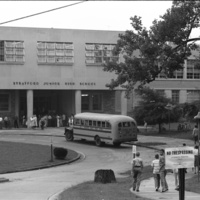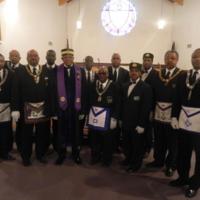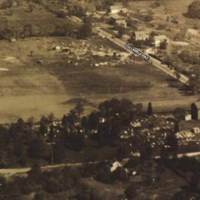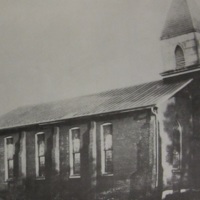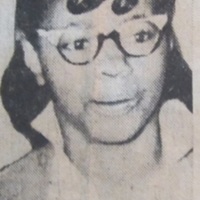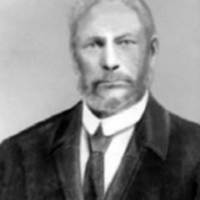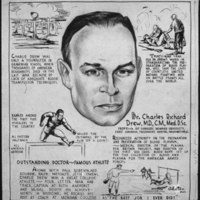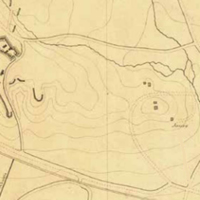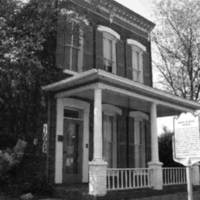Browse Items (28 items total)
In June of 1918 the first rural branch of the NAACP formed in Falls Church with the express goals of working against discrimination and segregation. Support for the NAACP and its causes continued to expand until Arlington County could support a separate dedicated branch in 1940 with 71 members. The branch would continue to grow and soon became one of the largest branches in the state. The organization worked to combat de jure and de facto discrimination, and was particularly active in battling Arlington's school segregation in the courts throughout the 1940s and 1950s. Thanks to this dedication on February 2, 1959 Arlington's Stratford Junior High School, pictured here, became the first school in the state of Virginia to integrate.
Collection: Community Institutions
Arlington's African American Masonic Lodge No. 58 was founded in the Green Valley community in 1888. The institution provided Arlington's growing black community with social, fraternal, and political support. Early members included community leaders Henry Louis Holmes and Edmund C. Fleet. The image above shows current members in the Masonic Lodge at their 2013 sunrise service.
Collection: Community Institutions
This African American fraternal organization was founded in Arlington's Freedman'c Village community in 1870. It served many needs of the newly established and growing black community – hosting social functions, serving as a meeting ground for political functions, serving as a credit union, helping to establish internal community leadership, and supporting black churches and schools. In 1884 the Odd Fellows purchased land in the African American, middle class, Johnson's Hill community to construct the Odd Fellows Steven's Lodge No. 1453. The institutions remained a central part of Arlington's civic-minded African American community through the twentieth century. The Hall was destroyed by fire in 1965.
Collection: Community Institutions
Mt. Olive was founded in 1873 when the Old Bell Baptist Church in Freedman's Village split into two churches. The new congregation built the brick and marble church pictured here in the geographical center of the growing working class black neighborhood of Queen City in eastern Arlington. In July of 1942, just three years after residents constructed a new and expensive church building, Mt. Olive was demolished along with the rest of the Queen City community to make way for the Pentagon's road networks. The church and its congregation relocated yet again, this time to Johnson's Hill.
Collection: Community Institutions
Gloria D. Thompson was born in 1946 to parents Clarence and Ethel Thompson. The Thompson family lived in Arlington's African American Hall's Hill neighborhood. Her mother Ethel was involved with the NAACP and added her children to Arlington's school integration cases. On February 2, 1959 twelve-year-old Gloria became one of four black students, and the only female, to integrate Arlington's Stratford Junior High School. She joined fellow Hall's Hill residents Ronald Deskins, Michael Jones, and Lance Newman. Stratford was the first school to integrate in the state of Virginia. After participating in such a major Civil Rights victory, Gloria continued her activism as a member of the Student Nonviolent Coordinating Committee (SNCC).
Collection: Civil Rights
William A. Rowe escaped enslavement and fled to Freedman's Village in Arlington, where he became a prominent community leader. Rowe was trained as a blacksmith in the Village and became a particularly successful African American politician. He served as Supervisor of Jefferson District from 1871 to 1879 and even served as Board chairman from 1872 to 1883. After the closure of Freedman's Village, Rowe relocated to Green Valley in 1879 with his wife and three children. Rowe quickly re-established his role as a local political leader in his new community, serving as the area's Supervisor.
Collection: Neighborhoods
Charles Drew was an African American surgeon and scientist whose pioneering work with blood plasma and transfusions saved countless lives during World War II. He ultimately left military service after the US Government attempted to segregate blood donations without any scientific need for such a policy. Drew served as a Professor at Howard University, the chief surgeon at Freedmen's Hospital, and became the first African American examiner for the American Board of Surgery. He died in a car accident in 1950 at the age of 45, leaving behind his wife Minnie and four children.
Collection: Civil Rights
In 1844 Sarah and Levi Jones purchased 14 acres of land in eastern Arlington along Four Mile Run to farm and build a home. Their property, labeled "Jones," can be seen at the center of the map above. Throughout the decades before and after the Civil War, the Jones family expanded their farm, sold land to fellow African Americans to help create the Green Valley neighborhood, and became community leaders.
Little is known about Sarah's life before 1844, but Levi was born free in Fairfax, Virginia. His parents, Davy and Evy, were enslaved on George Washington's Mount Vernon plantation.
Little is known about Sarah's life before 1844, but Levi was born free in Fairfax, Virginia. His parents, Davy and Evy, were enslaved on George Washington's Mount Vernon plantation.
Collection: Neighborhoods
Harry W. Gray was born into slavery at Arlington House plantation to parents Thornton and Selina Gray. Following the war Gray worked as a bricklayer before transitioning into work for the federal government, where he served first as a fireman and later an Assistant Messenger for the Department of the Interior.
With his skills in masonry, Gray built a large Italianate-style row home in the Johnson's Hill community in 1881. This home mimicked the style of houses then seen in Washington's African American Foggy Bottom neighborhood. Gray and his wife Martha raised four children in their home in Johnson's Hill. The Gray House is on the National Register of Historic Places.
With his skills in masonry, Gray built a large Italianate-style row home in the Johnson's Hill community in 1881. This home mimicked the style of houses then seen in Washington's African American Foggy Bottom neighborhood. Gray and his wife Martha raised four children in their home in Johnson's Hill. The Gray House is on the National Register of Historic Places.
Collection: Neighborhoods
The Gray House is an Italianate-style row home built by African American Harry W. Gray in the Johnson's Hill community of Arlington in 1882. The two-story, three-bay wide, red brick home mimicked the style of houses in Washington, D.C.'s Foggy Bottom neighborhood. With the use of this style, similar to those homes created by middle class African Americans in the nearby city, Gray illuminates his visions for what makes an area a good place to live and his aspirations for himself and his family in freedom.
Gray was born into slavery. During his time in enslavement he became a skilled mason and brick worker. He used these skills to build his home. After the Civil War Gray transitioned into work as a public servant with the Department of the Interior. Gray lived in the home in Johnson's Hill with his wife Martha, their four children, and two live-in servants.
The home was put on the National Register of Historic Places in 2003.
Gray was born into slavery. During his time in enslavement he became a skilled mason and brick worker. He used these skills to build his home. After the Civil War Gray transitioned into work as a public servant with the Department of the Interior. Gray lived in the home in Johnson's Hill with his wife Martha, their four children, and two live-in servants.
The home was put on the National Register of Historic Places in 2003.
Collection: Neighborhoods
